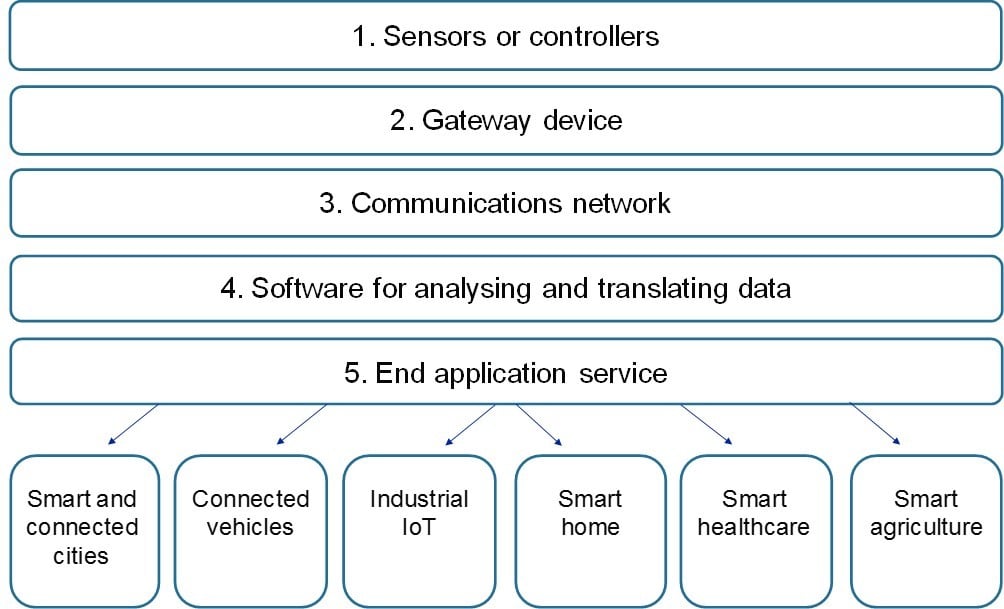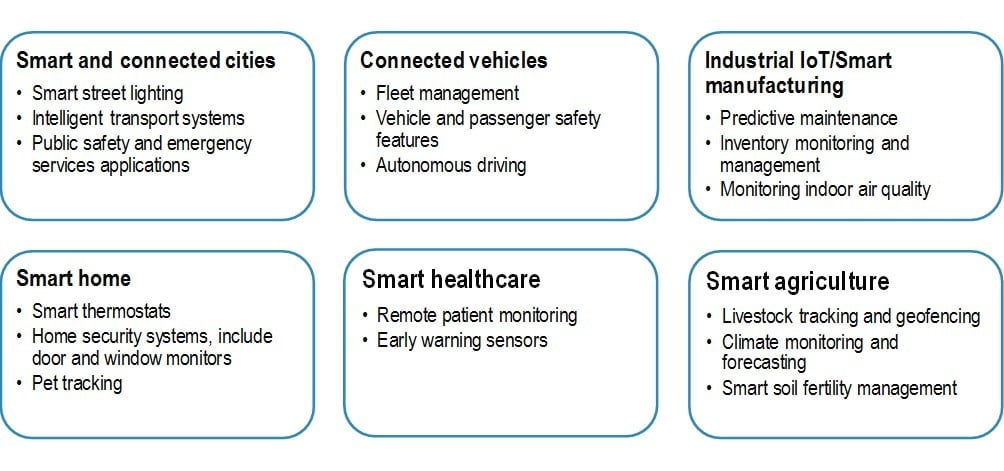Login to access
Want to subscribe?
This article is part of: Executive Briefing Service
To find out more about how to join or access this report please contact us
This report provides detailed analysis of the IoT ecosystem, the technologies enabling it, and how telcos can establish themselves within it, by presenting case-studies of strategies from AT&T, Vodafone, SK Telecom, and Deutsche Telekom. The report also discusses the connectivity needs of several different IoT use-cases.
The IoT ecosystem
The term IoT is used to describe a broad and diverse ecosystem that includes a wide range of different connectivity types and use-cases. Therefore, it is not helpful to discuss the IoT ecosystem as a whole, and to understand IoT better it is necessary to break it down into horizontal layers and vertical segments.
Figure 1: A simplified map of the IoT ecosystem

Source: STL Partners

The five horizontal layers in the figure above are essential elements common to all IoT use-cases, regardless of vertical segment, and comprise:
- Sensors or controllers (embedded in connected devices, the “things” in the Internet of Things)
- A gateway device to aggregate and transmit data back and forth via the data network.
- A communications network to send data.
- Software for analysing and translating data.
- The end application service.
Perhaps surprisingly we have not included ‘IoT platforms’ as a horizontal layer in its own right. IoT platforms are designed to organise, analyse, and (in some cases) act upon the data from connected devices. Because there can be differences in platform capabilities from vendor to vendor, a platform horizontal layer has not been included in this analysis. Depending on the platform, it will be designed to deliver any combination of horizontal layers 3, 4, and 5.
Level 5 – the end application service – is where material differences exist between vertical segments. Because IoT is a young market new use-cases are still emerging and existing use-cases are still evolving. The IoT ecosystem is not static and will continue to change, grow, and develop, and could look quite different in the next ten years. However, several distinct IoT vertical markets – sometimes described as ecosystems in their own right – are already emerging. These include:
- Smart and connected cities.
- Connected vehicles.
- Industrial IoT (including smart manufacturing).
- Smart home.
- Smart healthcare.
- Smart agriculture.
Within each of these six verticals there are several use-cases, and each vertical is developing and evolving new ones all the time. Figure 2 shows examples of use-cases either currently in use or under development in each vertical.
Figure 2: IoT vertical markets and use cases

Source: STL Partners
The complexity and technical requirements of each use-case varies widely. For example, the requirements of a smart thermostat compared to those of an autonomous vehicle are distinctly different. The next section of this report will provide an overview of the different technologies enabling IoT, followed by a section providing analysis of the technological requirements of several use-cases to illustrate how the IoT ecosystem will be enabled by not just one, but several different connectivity technologies.
- Executive Summary
- Introduction
- Methodology
- The IoT ecosystem
- Six key technologies enabling IoT
- 1. Cloud computing
- 2. Low-power wide-area technologies
- 3. Big data analytics
- 4. Network function virtualisation (NFV) and software-defined networking (SDN)
- 5. 5G
- 6. Edge computing
- Will one connectivity technology be dominant?
- Use-case one: Smart metering
- Use-case two: Autonomous driving
- Use-case three: Smart thermostat
- Use-case four: Smart home security system
- How will IoT use-cases evolve?
- Telcos’ role in the IoT ecosystem
- The IoT value chain
- AT&T: the ambitious ecosystem orchestrator
- Vodafone: a ‘connectivity plus’ approach
- SK Telecom: connectivity via multiple technologies
- Deutsche Telekom AG: the open platform integrator
- Adapting for evolution
- Figure 1: A simplified map of the IoT ecosystem
- Figure 2: IoT vertical markets and use-cases
- Figure 3: The role of ‘network slicing’ in IoT
- Figure 4: The role of Edge Computing in IoT
- Figure 5: Complexity profile criteria ratings
- Figure 6: Smart metering complexity profile
- Figure 7: Autonomous driving complexity profile
- Figure 8: Smart thermostat complexity profile
- Figure 9: Smart home security system complexity profile
- Figure 10: IoT use-case evolution
- Figure 11: Telco’s original role in the IoT ecosystem
- Figure 11: Telco’s current role in the IoT ecosystem
